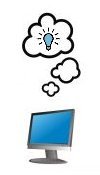Computer Invention
Cloud computing is the term used to describe technology that will replace how we currently use our computers and software applications.
The concept of cloud computing is that any device (computer invention) connected to the internet can utilize a network of computing resources.
This would include infrastructure, applications and storage for far less than what it would cost to use your own hardware, software and resources.
Additionally, it allows users to have access to applications that they would not have otherwise. Access is as simple as using an interface application or just a web browser from any location. 
The cloud can allow access to millions of computers in an intelligent, scalable and redundant system with expert support.
Similar to outsourcing, the difference and advantages of cloud computing are speed, efficiency, capability and cost, particularly with the increasing popularity of smart phones and tablets.
It allows users to work from anywhere, to perform any task with any application, and to pay for only what you use.
Cloud computing is comparable to using email or online banking where you log into your account to access and manage your information. The software, applications and storage do not exist on your computer.
But unlike your email or online banking services, clouds can perform complicated engineering tasks, schematics, modeling or mathematical computations, and it can do this in a cost effective and efficient manner.
Another major advantage to cloud computing is the reliability of service.
Servers can crash, temporarily denying you online access to services and data. But cloud computing has multiple servers so you always have access.
Some concerns about cloud computing are security and the effect it will have on the computer industry.
The security concerns are similar to those regarding email and online banking.
These have proven to have reliable security protocols therefore similar advanced technology has been adopted for cloud computing.
It's anticipated that computer repair and maintenance, as well as IT employment /contracts will steadily decline as cloud computing rises in popularity.
There has been a proliferation of free public clouds appearing on the internet.
These services, often referred to as SaaS (software as a service) are easy to use, fast, reliable and very good.
You can increase your use of cloud computing to meet a high demand on your resources and you can reduce your usage during low demand. This allows you to adapt to changing conditions without making significant long term investments in personnel, computers, software and operational costs.
Hopefully, cloud computing will assist independent inventors and small businesses to be more efficient and cost effective.
At the very least, it's a leveling of the playing field.
Computer Invention
This digital pen is a computer invention that transmits writing into digital media.
Although touch screen devices represent a movement away from paper, approximately eighty-percent of businesses still use paper based forms.
Many professions hand-write their notes, tables, diagrams and drawings instead of using tablets or other devices.
The computer pen is comparable to a regular ink pen (even uses refillable ink) that writes on regular paper, except it has an optical reader that records motion, images and coordinates. The recorded data is then transmitted to a computer via a wireless transmitter.
You can browse and edit your written notes, diagrams, tables, or drawings.
Another useful feature of this computer invention is that hand-written digital files can be easily converted into text fonts for use in word documents or emails.
Digital pen technology was first developed by the Swedish inventor and entrepreneur Christer Fåhraues.
Fåhraues is a physician and has an honorary doctorate degree in technology from Lund University in Sweden, and a M.Sc. degree in Bioengineering from the University of California San Diego.
Fåhraues served as the Chief Executive Officer and Chairman of Anoto Group AB, a company he originally founded in 1996 as C Technologies to license his digital pen technology.
This computer invention has been licensed to companies around the world for various commercial products. Applications include data/signature capture, completing forms, mapping, surveying, document management, paper replay, whiteboards, toys and education.
There are great expectations for digital pen technology over the next few years.
Sources: Anoto; Logipen
LaCie Safe
 Storing your files on this mobile hard drive gives you multiple levels of protection because it uses advanced encryption and biometric authentication technology.
Storing your files on this mobile hard drive gives you multiple levels of protection because it uses advanced encryption and biometric authentication technology.
The Safe uses 128-bit AES encryption (Advanced Encryption Standard) which is the same standard used by governments to protect top secret information.
Encryption converts information that is readable into a mixture of unreadable characters. Decryption processes the encrypted unreadable characters back into a readable format.
The algorithm that encrypts and decrypts the information is known as a cipher. The cipher allows access to the readable information when you enter a password.
![]() Most ciphers will use passwords that are four to eight characters in length, but a 128-bit AES cipher uses a 16 character password which is extremely difficult to hack.
Most ciphers will use passwords that are four to eight characters in length, but a 128-bit AES cipher uses a 16 character password which is extremely difficult to hack.
The AES cipher or "Rijndael" (pronounced Rein Dahl) is named after the Belgian inventors Joan Daemen and Vincent Rijmen.
 Biometric authentication is a technology that recognizes physical or behavioral characteristics such as fingerprints, palm geometry, retina patterns, voice and signature. Fingerprint recognition is the most popular because it's easier to use.
Biometric authentication is a technology that recognizes physical or behavioral characteristics such as fingerprints, palm geometry, retina patterns, voice and signature. Fingerprint recognition is the most popular because it's easier to use.
Your finger is scanned for minutia, which are the points on a fingerprint where a ridge ends or splits into two. An algorithm extracts the minutia points and creates a template image that is used for authentication.
Source: lacie.com



